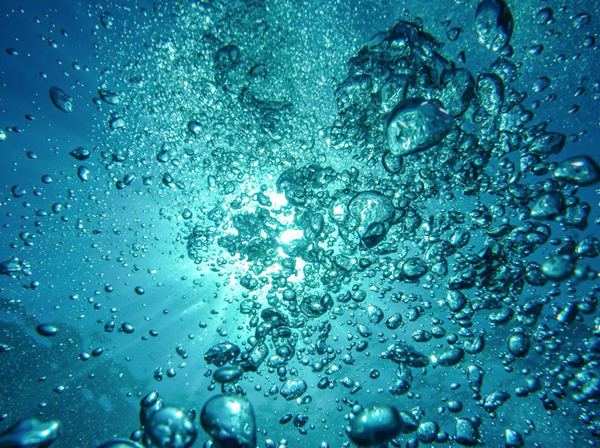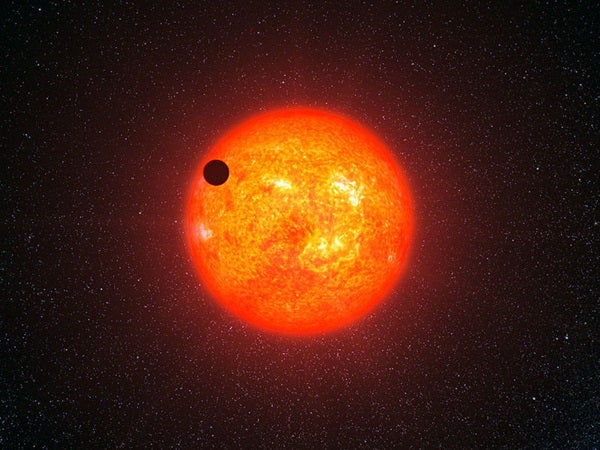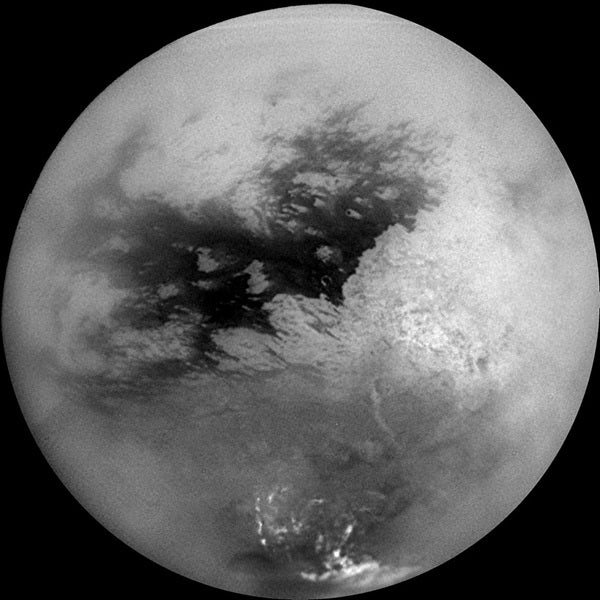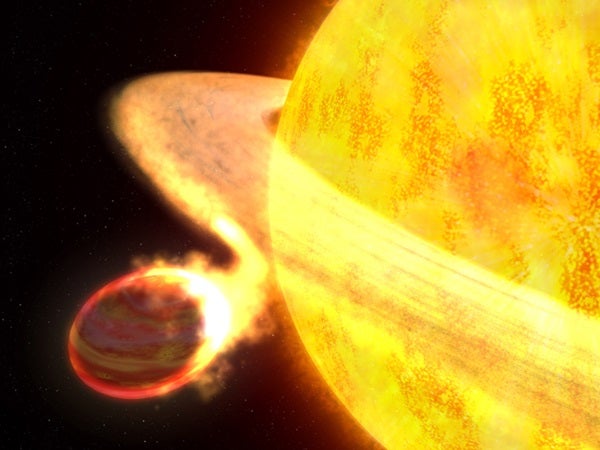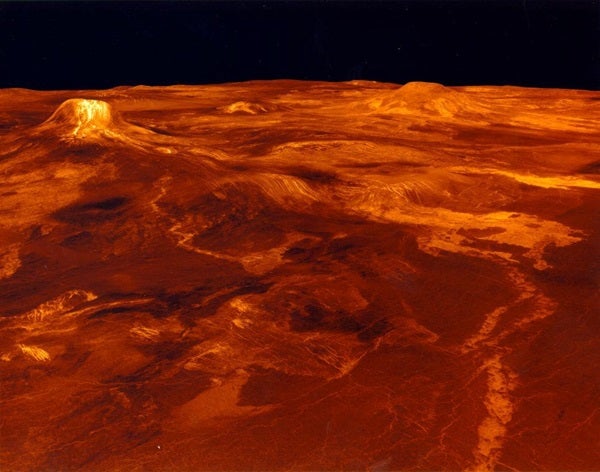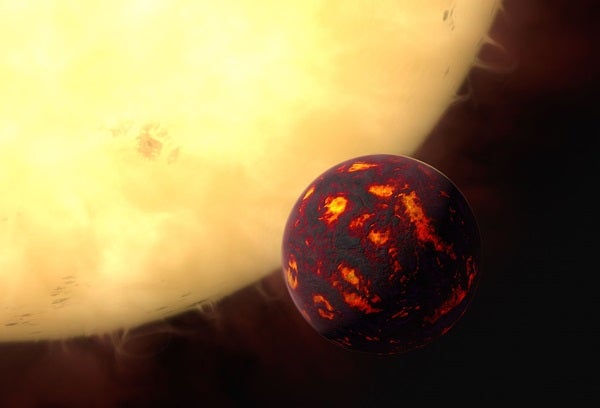We’ve found liquid water in lots of places in our solar system, but astronomers say there may be even stranger oceans out there, from charged plasma to sticky, gooey tar.
Some of the oceans on this list are still completely hypothetical, but the evidence says they’re all physically possible – which means that in an infinite universe, somewhere there must be an ocean of liquid ammonia washing up on an icy shore. Pack your bags and prepare to set sail on some of the strangest alien seas in the universe.
Water, Water Everywhere
On Gliese 1214b, 47 light years away in the constellation Ophiuchus, the ocean is technically made of water, but it’s still one of the last places in the universe you’d want to go for a swim. There’s probably no liquid water anywhere on the planet, according to a 2010 paper. Instead, under extreme heat and pressure, the water here takes on bizarre forms.
The upper layers of the atmosphere look normal enough: familiar clouds of water vapor, heated to about 540⁰F (280 C) thanks to Gliese 1214b’s proximity to its red dwarf star. As you dive further down into the planet’s watery envelope, though, the heat and pressure build up to such extremes that water starts behaving in some very weird ways.
When you heat a substance under very high pressure, it passes what’s called its supercritical point – the point at which the distinction between liquid and gas breaks down, and the material becomes a supercritical fluid, with some properties of both liquid and gas; it’s neither and both all at once. Supercritical water, produced under lab conditions, has industrial uses here on Earth, but there may be a globe-spanning ocean of it beneath the clouds of Gliese 1214b, under at least 218 times as much pressure as we feel on Earth’s surface.
Venture even deeper on Gliese 1214b, and you’ll find water in the form of an ionized gas called a plasma. A plasma forms when a gas gets energized enough to knock some electrons off its atoms. That gives the substance a positive charge. The result is an extremely hot, ionized material that’s neither a liquid nor a gas, but it behaves a bit like both. It’s also denser than supercritical water, and it’s very electrically conductive.
Most of the gas in our Sun and other stars is actually plasma, but the Sun’s hydrogen plasma is super-hot, over 9,940⁰F (5500 C). The deep ocean of plasma water on Gliese 1214b is relatively cool by comparison at just 6,700⁰F (3700 C).How does a planet get this watery and weird? When the Gliese 1214 system was forming, the outer reaches of its stellar disk were probably rich in water ice, much like the outer reaches of our own solar system. Gliese 1214b may have formed way out there, beyond what astronomers call the “snow line,” and then migrated inward, somehow managing not to accrete a lot of hydrogen or helium gas along the way. The result is a world bigger than Earth but smaller than Neptune and Uranus, with about six times the mass of Earth. Astronomers have said that it may be a type of planet that “could be thought of as a class of bigger, hotter versions of Jupiter’s icy moons.”
Is There A Methane Habitable Zone?
The seas and lakes of liquid methane on the surface of Titan are pretty well-known. It’s so cold on Saturn’s largest moon that frozen water behaves more like rock than like the ice we know here on Earth. Liquid methane, which usually exists only as a gas here on Earth, takes on the role of water, falling from the sky in big round drops to collect in methane rivers and flow into methane seas.
Planetary scientists were stunned by Titan’s strange alternate when the Huygens probe landed in 2005, but Titan may not be so unusual after all. In fact, worlds like Titan may be the rule, rather than the exception; University of Arizona planetary scientist Jonathan Lunine has suggested that there may be more liquid methane worlds out there than liquid water worlds like Earth.
Methane is a perennial favorite of astrobiologists looking for a chemical other than water in which alien cells could carry out the chemistry of life, and a pair of astrobiologists, Ashley Gilliam and Christopher McKay, even proposed in 2011 that there could be a “liquid methane habitable zone.” Here on Earth, methane is normally a gas because it needs really cold temperatures, about -292⁰F (180 C), to exist in liquid form. So around a red dwarf star like Gliese 581, you could find liquid methane on the surface of planets between 61.5 million and 154.1 million miles out. Gliese 581 has four known exoplanets, and astronomers are still debating whether with another two exoplanets actually exist. One of those hotly-debated candidates is in the liquid methane habitable zone, at about 71.5 million miles from the star.
Tarry Seas on Diamond Planets
About 1,200 light years away, there’s also an exoplanet that may have oceans of tar. The hot Jupiter WASP-12b is the only exoplanet we know of that has more carbon than oxygen. On planets like Earth, there’s usually about twice as much oxygen as carbon. When we say “rocky planets,” we don’t just mean “made of solid, hard stuff.” We mean, specifically, made of stuff that includes a lot of silica, a mineral composed of silicon and oxygen, the two most abundant elements on Earth.
On the other hand, WASP-12b’s ingredients list actually includes more carbon than oxygen, according to observations of its atmosphere. A carbon-rich world like WASP-12b could have a completely different geology, where instead of things like granite and gneiss, the crust is made mostly of things like diamond and graphite. Because WASP-12b itself is a hot Jupiter, it’s not the place to look for geology of any kind. If it’s rich in carbon as it appears, though, there’s a good chance that the whole WASP-12b solar system could have formed from the same carbon-rich disk of material, so there could be carbon-rich rocky exoplanets or moons in the WASP-12 system.
“This means that if smaller exoplanets are found to have carbon-rich atmospheres, their surfaces could be covered in a tar-like substance,” said MIT in a statement. These are planets that could have atmospheres, landforms, and even oceans that look very different from what we’re used to.
However, there’s an analog closer to home, albeit on a smaller scale. In Trinidad, a 75-meter-deep lake of natural asphalt, called Pitch Lake, formed when two faults intersecting deep beneath the island forced oil to the surface. The lighter components evaporated, leaving the thicker, heavier pitch behind. The same processes have produced similar lakes of pitch in California, Venezuela, and elsewhere. Each is home to a thriving ecosystem of microbes, including archaea that live on methane, bacteria that oxidize sulfur and nitrites to live, and fungi that feast on the unique form of carbon found in asphalt. These Earthly pitch lakes could yield some insight into the forms of life that might swim in hydrocarbon seas on other worlds.
Supercritical Oceans Closer to Home
Supercritical fluids may have also made an appearance as rivers, lakes, and oceans on ancient Venus. Today Venus is a dry, hot, crushing hellworld, but the tale of a very different planet is still etched on its surface in the form of features that look very much like canyons, lakebeds, and broad plains that may once have been sea floors. Scientists are still debating what type of liquid shaped the surface of Venus; water and lava flows are both popular theories. But the liquid flowing across that ancient landscape may have been not water, but supercritical carbon dioxide.
Today, carbon dioxide makes up over 96% of the Venusian atmosphere, so there’s plenty of material to work with if you want to create a supercritical carbon dioxide ocean; you just need slightly higher temperatures and pressures, and early Venus delivers. Much earlier in the solar system’s history, the surface pressure on Venus was many times higher than it is today – which is impressive, because today it’s a crushing 91.8 atmospheres. The temperature was over 1340⁰F (727 C), compared with today’s relatively mild 863⁰F (462 C) average. That’s well beyond the supercritical point of carbon dioxide – enough to make it behave a bit oddly even for a supercritical fluid.
The result, according to a 2014 paper, may have been rivers, lakes, and oceans of a bubbly, patchy sort of supercritical fluid that flowed a bit more like a liquid, with bubbles that behaved a little more like gas, popping up where the temperature and pressure varied a bit. When temperatures and pressures soar way above carbon dioxide’s critical point, the fluid isn’t smooth and uniform anymore, because it turns out that supercritical fluids can change their behavior really quickly with fluctuations in pressure and temperature, so it would be easy for bubbles with a different consistency to pop up.
So according to physicist Dima Bolmatov and his colleagues, it’s plausible that Venus’s landforms are “the fingerprints of near-surface activity of liquid-like supercritical CO2.”
Seas of Molten Rock
The floor really is lava on some worlds, which are covered by burning oceans of molten rock.
Take 55 Cancri e, a super-Earth orbiting a main-sequence star 41 light years away, for instance. It’s tidally locked to its star, so one side of the planet is permanently scorched by stellar radiation at a range of just 2.24 kilometers, with its surface temperature averaging over 4500⁰F (2480 C). At that temperature, the surface on 55 Cancri e’s dayside would be entirely molten – an entire hemisphere of lava ocean. The planet was once thought to be carbon-rich, like WASP-12b, but it turns out that 55 Cancri e’s burning ocean may be plain old silicate lava, not liquid diamonds. Even so, it would be a great place to play “the floor is lava,” or maybe stage a fight to the death with your former Jedi apprentice.
So far, scientists haven’t found a good explanation for that. The night side, meanwhile, is a still-scorching 2010⁰F (1100 C), cool enough to have solid ground underfoot and perhaps even a little bit of atmosphere. According to Spitzer’s thermal mapping, a significant amount of that heat probably comes from the inner workings of the planet itself, which is unusual for a tidally-locked world, where tectonic activity should long since have ground to a halt. Scientists still haven’t found a good explanation for that, but it’s possible that it could be a hint of other exoplanets in the 55 Cancri system.
55 Cancri e isn’t the only lava world in the universe, either, so you have another option for that Jedi death match. 480 light years away in the constellation Monoceros, the super-Earth CoRoT-7b is tidally locked to its yellow dwarf star, which it orbits at a close range of just 1.5 million miles. CoRoT-7b’s neighbors help keep it active despite the tidal lock; tidal forces from two other exoplanets in the system keep the planet’s interior hot and moving, so the planet’s 4000⁰F (2200 C) dayside, much like that of 55 Cancri e, is an ocean of liquid rock. The night side is a much cooler -350⁰F (-212 C), but still sees constant volcanic eruptions. .
Surf’s Up!
Some of the greatest adventure stories on Earth take place on the high seas, often in the blank spots on the map, marked only “Here Be Dragons.” A map of the galaxy, however, offers even wilder oceans to explore, and someday bold adventurers might sail on seas of lava, plasma, tar, methane, or strange supercritical fluids.
A few of these bizarre oceans might even harbor life in strange forms we can only speculate about for now. Maybe there are microbes living in the tarry seas of a carbon-rich world around Wasp-12, or maybe some future mission will encounter methane-dwelling sea monsters on Titan. One thing is certain: the universe is a wet, wild place, and there are far, far more than seven seas to explore.

